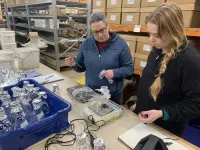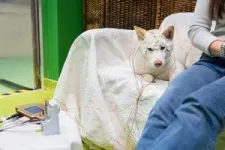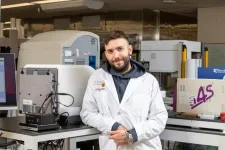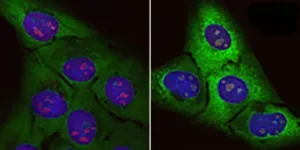(Press-News.org) Researchers have for the first time discovered evidence of microplastic contamination in archaeological soil samples.
The team discovered tiny microplastic particles in deposits located more than seven metres deep, in samples dating back to the first or early second century and excavated in the late 1980s.
Preserving archaeology in situ has been the preferred approach to managing historical sites for a generation. However, the research team say the findings could prompt a rethink, with the tiny particles potentially compromising the preserved remains.
Microplastics are small plastic particles, ranging from 1μm (one thousandth of a millimetre) to 5mm. They come from a wide range of sources, from larger plastic pieces that have broken apart, or resin pellets used in plastic manufacturing which were frequently used in beauty products up until around 2020.
The study, published in the journal Science of the Total Environment, was carried out by the universities of York and Hull and supported by the educational charity York Archaeology.
Professor John Schofield from the University of York’s Department of Archaeology, said: “This feels like an important moment, confirming what we should have expected: that what were previously thought to be pristine archaeological deposits, ripe for investigation, are in fact contaminated with plastics, and that this includes deposits sampled and stored in the late 1980s.
“We are familiar with plastics in the oceans and in rivers. But here we see our historic heritage incorporating toxic elements. To what extent this contamination compromises the evidential value of these deposits, and their national importance is what we'll try to find out next.”
David Jennings, chief executive of York Archaeology, added: “We think of microplastics as a very modern phenomenon, as we have only really been hearing about them for the last 20 years, when Professor Richard Thompson revealed in 2004 that they have been prevalent in our seas since the 1960s with the post-war boom in plastic production,”
“This new study shows that the particles have infiltrated archaeological deposits, and like the oceans, this is likely to have been happening for a similar period, with particles found in soil samples taken and archived in 1988 at Wellington Row in York.”
The study identified 16 different microplastic polymer types across both contemporary and archived samples.
“Where this becomes a concern for archaeology is how microplastics may compromise the scientific value of archaeological deposits. Our best-preserved remains – for example, the Viking finds at Coppergate – were in a consistent anaerobic waterlogged environment for over 1000 years, which preserved organic materials incredibly well. The presence of microplastics can and will change the chemistry of the soil, potentially introducing elements which will cause the organic remains to decay. If that is the case, preserving archaeology in situ may no longer be appropriate,” added David Jennings.
The research team say further research into the impact of microplastics will be a priority for archaeologists, given the potential impact of these man-made chemicals on archaeological deposits.
The study, ‘The contamination of in situ archaeological remains: A pilot analysis of microplastics in sediment samples using μFTIR’, has been published in Science of the Total Environment.
ENDS
END
Scientists uncover evidence that microplastics are contaminating archaeological remains
Researchers have for the first time discovered evidence of microplastic contamination in archaeological soil samples
2024-03-22
ELSE PRESS RELEASES FROM THIS DATE:
Toronto researchers devise new way to find proteins for targeted treatment of disease
2024-03-22
Researchers at the University of Toronto and Sinai Health have created a new platform to identify proteins that can be co-opted to control the stability of other proteins — a new but largely unrealized approach to the treatment of disease.
The researchers developed a method to interrogate the entire human proteome for ‘effector’ proteins, which can influence the stability of other proteins via induced proximity. The study marks the first time researchers have searched for effector proteins on this scale, and has identified many new effectors that could be used therapeutically.
“We found more than 600 new effector proteins in 14,000 ...
Researchers invent artificial intelligence model to design new superbug-fighting antibiotics
2024-03-22
Attention editors: Under embargo by the journal Nature Machine Intelligence until Friday, March 22, 12 p.m. eastern
Hamilton, ON, Mar. 22, 2024 – Researchers at McMaster University and Stanford University have invented a new generative artificial intelligence model which can design billions of new antibiotic molecules that are inexpensive and easy to build in the laboratory.
The worldwide spread of drug-resistant bacteria has created an urgent need for new antibiotics, but even modern AI methods are limited ...
An avocado a day may improve overall diet quality, researchers report
2024-03-22
UNIVERSITY PARK, Pa. — Eating one avocado per day may improve overall diet quality, according to a team led by researchers in Penn State’s Department of Nutritional Sciences. Poor diet quality is a risk factor for many diseases, including heart disease, and many American adults have poor diet quality and do not meet key dietary recommendations provided by the Dietary Guidelines for Americans.
This study was led by Kristina Petersen, associate professor of nutritional sciences, and Penny ...
CU researchers describe tools to better understand CaMKII, a protein involved in brain and heart disease
2024-03-22
AURORA, Colo. (March 22, 2024) – The health impacts of a complex protein that plays a major role in the development of Alzheimer’s disease and heart conditions can be lessened by three kinds of drug inhibitors, according to scientists at the University of Colorado Anschutz Medical Campus.
In an overview of the protein and the inhibitors published today in the journal Cell Reports, the CU researchers discussed the best ways to use the interventions.
The protein, CaMKII, is ubiquitous in cells throughout the body but is perhaps best known for its prominent role in the brain and the heart. It is critical in learning and memory but if misregulated can ...
Theoretical physicist Carlo Rovelli to receive 2024 Lewis Thomas Prize
2024-03-22
From photons to atheism to Churchill’s extraterrestrial musings, the stunning breadth of Carlo Rovelli’s work has spurred readers to think deeply about the intersection of science and culture, transforming staggering complexity into widely accessible writing along the way.
For this artful ability to educate and engage, Rovelli will be presented with the 2024 Lewis Thomas Prize for Writing about Science at The Rockefeller University on April 9. Named after its first recipient, noted physician-scientist and essayist Lewis Thomas, the prize was ...
Your dog understands that some words “stand for” objects
2024-03-22
It’s no surprise that your dog can learn to sit when you say “sit” and come when called. But a study appearing March 22 in the journal Current Biology has made the unexpected discovery that dogs generally also know that certain words “stand for” certain objects. When dogs hear those words, brain activity recordings suggest they activate a matching mental representation in their minds.
“Dogs do not only react with a learned behavior to certain words,” says Marianna Boros (@FamDogProject) of the Department of Ethology at the Eötvös Loránd University, Budapest, Hungary, one of the paper’s co-first authors. “They also don’t ...
Your dog understands that some words ‘stand for’ objects, new study shows
2024-03-22
It’s no surprise that dogs can learn to understand and respond to human words. Your dog can learn to sit when you say “sit” and come when called. But a new study has made the surprising discovery by recording brain activity that dogs generally also know that certain words “stand for” certain objects. When they hear those words, they activate a matching mental representation in their minds.
“Dogs do not only react with a learned behavior to certain words,” says Marianna Boros of the Department of Ethology at the Eötvös Loránd University, Budapest, Hungary. “They also don’t just associate that word with an object ...
Accumulation of 'junk proteins' identified as one cause of aging and possible source of ALS
2024-03-22
CNIO researchers provide a new hypothesis to understand the origin of amyotrophic lateral sclerosis, or ALS. It would be triggered by a similar problem to that occurring in a group of rare diseases called ribosomopathies.
In ALS patients, motor neurons would accumulate an excess of non-functional ribosomal proteins that eventually collapse the cell's clearance systems and cause toxicity.
The study also opens a new front in aging research. The authors provide experimental evidence that formally proves a kind of stress called ‘nucleolar stress’ cause aging in mammals.
Amyotrophic lateral sclerosis (ALS) is a degenerative disease. ...
Movement disorder ALS and cognitive disorder FTLD show strong molecular overlaps, new study shows
2024-03-22
On the surface, the movement disorder amyotrophic lateral sclerosis (ALS), also known as Lou Gehrig’s disease, and the cognitive disorder frontotemporal lobar degeneration (FTLD), which underlies frontotemporal dementia, manifest in very different ways. In addition, they are known to primarily affect very different regions of the brain.
However, doctors and scientists have noted several similarities over the years, and a new study in Cell reveals that the diseases have remarkable overlaps at the cellular and molecular levels, revealing potential targets that could yield therapies applicable ...
Patient characteristics and telemedicine use in the US, 2022
2024-03-22
About The Study: In this study of 5,437 U.S. adults with health care visits in 2022, many patients, including those with the greatest care needs, chose telemedicine even after in-person visits were available. These findings support continuing this care delivery approach as an option valued by patients. Differences were not observed by most common measures of socioeconomic status. Continued monitoring of telemedicine use is needed to ensure equitable access to health care innovations.
Authors: Eva ...
LAST 30 PRESS RELEASES:
University of Oklahoma researcher awarded funding to pursue AI-powered material design
Exploring how the visual system recovers following injury
Support for parents with infants at pediatric check-ups leads to better reading and math skills in elementary school
Kids’ behavioral health is a growing share of family health costs
Day & night: Cancer disrupts the brain’s natural rhythm
COVID-19 vaccination significantly reduces risk to pregnant women and baby
The role of vaccination in maternal and perinatal outcomes associated with COVID-19 in pregnancy
Mayo Clinic smartwatch system helps parents shorten and defuse children's severe tantrums early
Behavioral health spending spikes to 40% of all children’s health expenditures, nearly doubling in a decade
Digital cognitive behavioral treatment for generalized anxiety disorder
Expenditures for pediatric behavioral health care over time and estimated family financial burden
Air conditioning in nursing homes and mortality during extreme heat
The Alps to lose a record number of glaciers in the next decade
What makes a good proton conductor?
New science reporting guide published for journalists in Bulgaria
New international study reveals major survival gaps among children with cancer
New science reporting guide published for journalists in Turkey
Scientists develop a smarter mRNA therapy that knows which cells to target
Neuroanatomy-informed brain–machine hybrid intelligence for robust acoustic target detection
Eight SwRI hydrogen projects funded by ENERGYWERX
The Lundquist Institute and its start-up company Vitalex Biosciences Announces Strategic Advancement of Second-Generation fungal Vaccine VXV-01 through Phase 1 Trials under $40 Million Competitive Con
Fine particles in pollution are associated with early signs of autoimmune disease
Review article | Towards a Global Ground-Based Earth Observatory (GGBEO): Leveraging existing systems and networks
Penn and UMich create world’s smallest programmable, autonomous robots
Cleveland researchers launch first major study to address ‘hidden performance killer’ in athletes
To connect across politics, try saying what you oppose
Modulating key interaction prevents virus from entering cells
Project explores barriers to NHS career progression facing international medical graduates
Jeonbuk National University researchers explore the impact of different seasonings on the flavor perception of Doenjang soup
Two Keck Medicine of USC Hospitals named Leapfrog Top Teaching Hospitals
[Press-News.org] Scientists uncover evidence that microplastics are contaminating archaeological remainsResearchers have for the first time discovered evidence of microplastic contamination in archaeological soil samples







